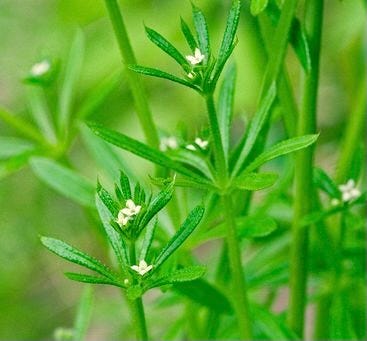Cleavers (Galium aparine) is a common wild plant in this region usually found in moist areas, and often but not always, in areas with some shade. It will soon bear its tiny white flowers. It is best picked just before the onset of flowering.
It goes by many names and it has some look alikes so make sure you are identifying it correctly. Sometimes referred to as Sticky Willy or Catchgrass, the plants feel sticky when you rub your hand over the stalks and leaves and they have a tendency to stick to your clothing. Cleavers has the scent of “new mown hay” early in the season, which you will also find in a few of its cousins Sweet Woodruff (Galium odorata) and Fragrant Bedstraw (Galium triflorum). Cleavers is sometimes also referred to as Bedstraw. There are other plants including numerous ones in the Galium genus that also carry this name.
The lovely vanilla-like new-mown hay scent indicates the presence of coumarins, giving this plant an affinity to helping to thin the blood and keep it fluid. It has a strong affinity to fluids in the body in general, being among the most important herbs addressing the lymphatic system and acting as a general alterative. As such it has traditionally been used in cancer. It also has an affinity to the lymphatic tissues of the gut. It can be helpful in glandular swellings, including mono, as well as all sorts of cystic and fibrous tendencies. It is of use in fibrocystic breasts and breast cysts in general.
It’s effects on the lymphatic system include that of draining the lymphatics of the brain, eyes, head and neck. While it helps drain the fluids of the head and neck, it also moistens dry eyes and can be helpful for eye conditions in general. It can help relieve patterns of tension, including that of the neck. It is indicated for an overly busy mind that goes around in circles, entwining itself in its own thoughts. It can bring ease and focus to the mind.
Its action on the urinary system and kidneys make it a useful diuretic as well as being helpful in all sorts of urinary issues including bladder infections, tendencies to stones, and urinary issues associated with prostate issues.
You can make a fresh tea of the leaves and stalks. It is best used fresh, made into a fresh tincture or as a topical oil, If you want to dry it to use as tea, do so quickly and carefully so as to preserve the scent as much as possible. It is edible and can be steamed as a green vegetable if used early in the season. Being in the coffee family, once its flowers turn to seed, they can apparently be roasted and used in place of coffee.





